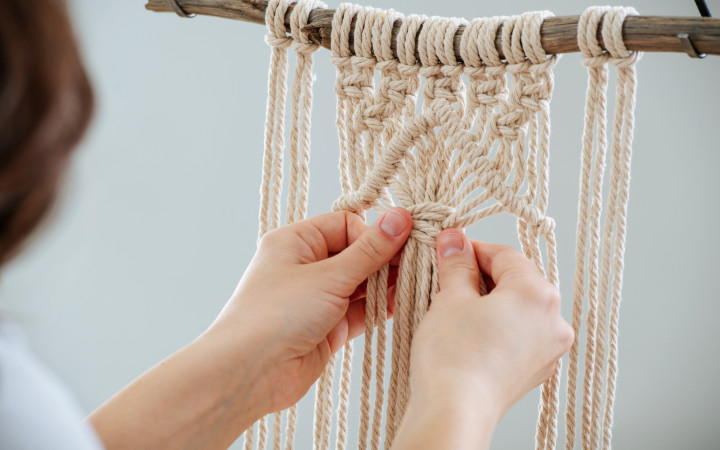Today’s Wonder of the Day was inspired by Ellie. Ellie Wonders, “how to do macrame?” Thanks for WONDERing with us, Ellie!
Are you crafty? If you’ve been WONDERing with us for a while, you may have read a thing or two about crafts. Maybe you’ve learned how to make a ship in a bottle or a friendship bracelet. Perhaps you’ve even tried your hand at kintsugi. Today’s Wonder of the Day is all about another popular craft—macramé!
What is macramé (say “ma-kruh-may”)? It’s the practice of tying knots with cords to make works of art. Have you ever seen an example of macramé? It’s a popular method for creating plant hangers, wall hangings, and even curtains.
Macramé has a long history. No one can say for sure when the first of these creations was made. However, most people today believe the craft reaches all the way back to the ancient Babylonians and Assyrians. That’s thanks to carvings that seem to depict macramé decorations made by these cultures.
Later, macramé was a popular technique among Turkish weavers in the 13th century. Many believe the craft spread throughout much of eastern Asia and northern Africa. The word macramé arose from either the Turkish word makrama (“napkin” or “towel”) or the Arab word migramah (“fringe”).
Macramé soon caught on in Spain after the arrival of people from northern Africa. From there, the craft spread all over Europe. It became especially popular among sailors. As experts in creating knots, they quickly adopted macramé as a hobby to pass the time aboard their ships. Thanks to these sailors, macramé spread to harbors all over the world.
In the modern world, macramé was very popular in the 1960s and 1970s as a way to create hand-woven crafts. Today, the practice is again making a comeback. Do-it-yourself (DIY) enthusiasts everywhere can make their own macramé decorations with just a few items.
How do you make macramé? Start by gathering the right supplies. You’ll need a cord, a support, and a pair of scissors. Macramé cords come in a variety of sizes and materials—the one you need will depend on what you’re trying to create. The support is the item you’ll tie your knots to. This, too, can take many forms. Common supports include dowel rods, branches, and solid hoops.
After gathering the right supplies, it’s time to start creating! Many people choose to follow macramé patterns, especially as beginners. These are available online and at many craft stores. However, after some experience, you may be able to make up your own patterns based on the knots you like most.
Common macramé knots include the lark’s head knot, reverse lark’s head knot, square knot, half knot, spiral stitch, and clove hitch. People who are new to macramé can find instructions for making each type of knot online. However, it’s important to know a few terms before getting started.
In macramé, the working cord is the section of cord used to make each knot. The filler cord is the piece of cord each knot wraps around. Finally, a sennit is a knot or series of knots that are repeated.
Have you ever seen a beautiful piece of macramé art? Are you ready to make your own? This could be the perfect DIY craft to do with your family—ask an adult to help you get started.
Standards: CCRA.R.4, CCRA.L.3, CCRA.L.6, CCRA.R.10, CCRA.R.2 CCRA.R.1, CCRA.SL.1, NCAS.A.1, NCAS.A.2, NCAS.A.3, CCRA.W.2, CCRA.W.4, CCRA.L.1




